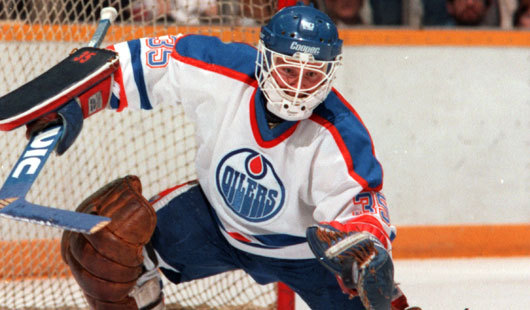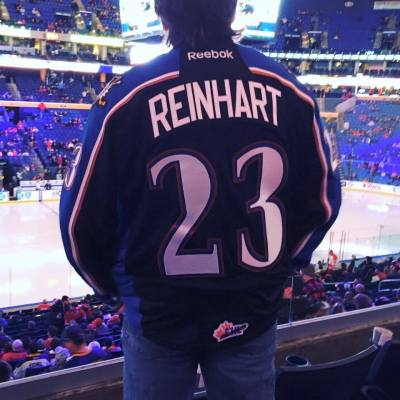
In front of him during his 18 NHL seasons was a long list of Hall of Fame caliber teammates. Gretzky. Messier. Fuhr. Kurri. Bourque. Recchi. Neely. Modano. Nieuwendyk. So many other names, that the 1990 Jennings Trophy and 3-time Stanley Cup winning goalie, Andy Moog, often gets overlooked. Closing in on twenty years since his last NHL game, Moog’s accomplishments to the game of hockey are nearly forgotten. This is a shame in my eyes. Not only because Moog was always one of my favorite goaltenders, but also because I believe his achievements are noteworthy. The argument could even be made that what Moog did on the ice should make him a consideration for Hall of Fame candidacy.
I will focus on a couple of key numbers. First, and perhaps the most remarkable – Andy Moog was the second fastest goaltender in NHL history to record 300-wins. It took Moog only until his 543rd game to reach this feat. The only goaltender that did it faster was the great Jacques Plante. But what makes this achievement so much more significant is the fact that Moog never played more than 62-games in a season, and only 5-times did he play at least 50-games in a season during his 18-year run. Plante, on the other hand, had 9-seasons of at least 50-games played, including the 1961-62 season when he suited up for all 70 of Montreal’s games (Plante also played in 69 of 70 games of the 1959-60 NHL season).
Take a look at a few particular contemporaries of Moog’s that are also members of the 300-win club. Martin Brodeur, Dominik Hasek, Grant Fuhr, Curtis Joseph, Eddie Belfour. All five goaltenders played during the same era as Moog, have at least 300-wins and in some cases well over 400-wins (Brodeur leading the pack with an astonishing 691), and all had at least one season where they played in 70 or more games. Moog still reached 300 career wins faster than any of them. Of these same contemporaries, only Brodeur and Hasek have better career win percentages than Moog; Andy having won 52.17% of his career regular season games. No matter how you splice it, to recognize that Moog was able to hit this milestone faster than anyone else except for one other goaltender, and in less games, has to count for something.
The other number that I would like to pinpoint about Andy Moog is career appearances in the Stanley Cup Finals. Not only did Moog win three Stanley Cups during the Edmonton Oilers dynasty years (Moog was a member of Edmonton’s championship teams in 1984, 1985 and 1987), but he also played in the Finals on three other occasions. In fact, between 1983 through 1990, only two years did a team make it to the Stanley Cup Finals that did not have Andy Moog as one of their goaltenders. Only former teammate Grant Fuhr equaled that task of six Finals appearances during the same time period. Fuhr and Moog being teammates for the first four Finals series together in Edmonton (1983, 1984, 1985, 1987), and then adversaries for the later two (1988 and 1990). Moog tended goal for a total of 15 Stanley Cup Finals games, and although his record in those games played is not ideal (3-wins, 10-losses), Moog still has his name inscribed on the Cup three times as a player.
How quickly he surmounted 300 career wins and the number of appearances in the Finals are what I find to be most impressive about Moog’s NHL career. But most certainly, there are other numbers of Andy’s that can be looked at and appreciated. Fast approaching twenty years since his last NHL game, Moog still sits at 15th place for all-time career wins with 372. That is more wins than Hockey Hall of Fame enshrined goalies Gump Worsley, Harry Lumley, Billy Smith, Bernie Parent or Ken Dryden.
Playing during a time period when goal scoring was at its most prolific, Moog still possesses a solid career save percentage. In 713 regular season games, Moog finished his career with a .892 save-percentage. You have to take into consideration that this number was attained throughout seasons when opposing players like Brett Hull and Mario Lemieux were scoring over 80-goals a season, and Bernie Nicholls, Teemu Selanne, and Alexander Mogilny were surpassing the 70-goal plateau (obviously I did not count Moog’s teammates during a portion of this era, Wayne Gretzky and Jari Kurri who put up astronomical numbers themselves).

Andy Moog was also an NHL All-Star in 1985 and 1986 when both he and Grant Fuhr were selected together as goaltending teammates, as well as selections in 1991 and 1997. In an era before NHL players were allowed to play in the Winter Olympics, Andy Moog shared the goaltending duties for Team Canada during the 1988 Calgary Olympics and helped lead Canada to a fourth-place finish, after he decided to leave the NHL briefly in 1987 to play for the Canadian national team. These are just a couple other achievements of Moog’s that I feel are worth noting.
This is what often happens when you play on great teams. Superb players like Andy Moog fall into the backdrop. In Edmonton, there were just too many great names during those dynasty teams and everybody remembers Grant Fuhr as the cornerstone in goal. Moog gets forgotten. Especially because Fuhr became the frontrunner in net for the Oilers, and at best for Andy, he and Fuhr were a tandem; it was never really the case that Moog was the number one guy while the Oilers were winning Cups; it was either Fuhr or the duties were shared.
In Boston, Moog’s heroics were kept out of the limelight by the accolades achieved by Bruin superstars Ray Bourque and Cam Neely, not to mention the fact that once again the goaltender duties were shared concurrently with Rejean Lemelin, although this time Moog had the edge towards being number one. Then in Dallas and in Montreal, Moog was certainly the number one goalie, but it was achieved during the final leg of his long career. Moog put up very solid numbers with both the Stars and the Canadiens, but I think arguably his best years in the game had already been played by that point.
Yes, this is what happens when you play on great teams. I think Ken Dryden experienced it in Montreal playing behind Guy Lafleur, Larry Robinson, Guy Lapointe, Serge Savard, Bob Gainey and all those great Habs players. I think that Chris Osgood can also relate from his time with the Detroit Red Wings teams of the late-90s and 2000s. Most people do not even know that Osgood is in eleventh place on the all time wins list by a goaltender and that he reached the 400-mark.

I hope that in writing this I can at least draw some attention back to Andy Moog and what he accomplished during his NHL career. Do not overlook him. I remember seeing Andy in net in Buffalo at the old Aud on November 15th, 1995 when he was with the Dallas Stars. The Sabres won the game 2-1 (it was also the same night that “The French Connection’s” jerseys were retired in unison), but Moog turned in a decent 17-save performance for a 0.895 save-percentage that evening. Sitting in the stands with my father, I felt fortunate that I was getting to see Andy Moog play in person. I hope that anyone else who got to witness him play, whether as a fan, teammate, rival, coach, or official, feels at least a little privileged to have seen Moog play. Or at the very least, is able to recognize that they were witnessing a player who was better than most. Not to be overlooked.

I wholeheartedly agree. Andy Moog should be in the Hockey Hall of Fame. I recently watched Game 3 of the Campbell Conference Championship of 1983 versus Calgary and Game 5 of the 1994 Stanley Cup Finals against the legendary New York Islanders. Andy Moog was a stellar goal tender! Without Moog in net, they lose both of those games. and if we had a time machine, Moog could play in todays NHL. As you stated, he appears to have fallen in the shadows of the giants he played with in those high flying years.
LikeLike